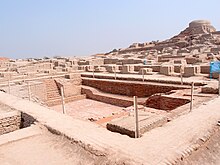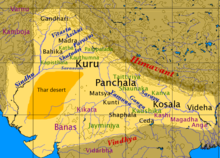SEHWAN THROUGH THE CENTURIES
By Late Prof. C. L. Mariwalla – recompiled by J. C. Mariwalla
It seems a strange irony of fate that like all material things cities must also rise and fall.
Sehwan in central Sindh has its own past and one worthy of recount. Today it may seem a haunt or a hamlet but the days of her glory are not unknown to the world. It had an enviable past since the Hindu Raj, long before the Macedonians invaded the country, till the time of Talpurs. “When our rule began the place declined in its scale of prosperity” so wrote Burton.
Sehwan throughout these long centuries has enjoyed an importance of its own. It has been for a time the capital of the province. The well known ecstatic prince Raja Bharat Hari resided here. Along with
Shikarpur and
Thatta it has been the market place of Sindh. It also enjoyed strategic importance till the Indus forsook it in the last century. Its antiquity is unquestionable and unsurpassed. The Sindh Gazetteer says that
there is not town in all Sindh still surviving which can be traced as far back as Sehwan. And Dr. Kennedy remarks in this connection,
“The ruins of Sehwan form by far the most important relic of antiquity, the only spot worth visiting to satisfy curiosity of this kind in all Sindh.”
Sehwan has undergone many modifications in its name. It has been plausibly identified with Sindemona, so says the Gazetteer.
Sehwan bears other names that have their justification. Todd identifies
Sehwan with Shivistan or Siwistan meaning the abode of Lord Shiva, thus giving us a clue that it had existed in the Hindu period. Sehwan was the seat of Raja Bharat Hari during the reign of his brother Vikramaditya, Chandragupt II. Further the Fort of Sehwan is populary called Kafir Killa, meaning that it existed long before Mohammedan conquest of Sindh. All these facts show that Sehwan definitely belongs to the Hindu period.
Sehwan, in central Sindh, is situated on an eminence at the verge of a swamp. “
Sehwan was almost surrounded by water commanding the Lakki pass. It was a place that every invader was bound to seize and to keep hold of, if he wished to be sure of his position.” The strategic importance of this place was recognized even by the British military officers, just before the conquest of Sindh. Strategically situated,
Sehwan was well protected by soaring Lakki hills for a back drop and the Indus touched its feet and enriched the lands surrounding it with its rich alluvium.
Sehwan is about eleven miles from 'Lakky' village and nearly twelve miles from Manchhar lake. While its commanding look beckoned the warriors of yore to occupy it, if they wished to be the masters of the valley, the green verdure of its extensive hinterland lured men of enterprise and ingenuity to it, to harness bountiful nature for their benefit. The Indus, flowing near by the town, made
Sehwan an entrepot of commerce of an unfathomable magnitude. Because of its commanding position
Sehwan became the capital city of the region from early Hindu times till the Muslim conquest of Sindh in 711 A.D. Thereafter too it invariably was the 'seat of government' right upto British times.
SOME OF THE FAMOUS LANDMARKS OF SEHWAN ARE :
Great Fort of Sehwan :
The early rulers had realized that Sehwan commanded a key position in the centre of Sindh and therefore they erected here a massive fort.
There is a tradition at Sehwan that the fort was built by
Alexander the Great. But there is other evidence to show that the fort had existed before Alexander came to India and it may be conjectured correctly that he got it repaired to suit his army requirements. The considered opinion of Dr. Kennedy and Sir Burton is that the arches of the fort and other peculiarities are indisputably oriental and not Grecian. Burton says, “It cannot, I humbly opine, be of Grecian origin for two reasons, the arches are Asiatic and the broken bits of man's handwork scattered about in its entrails are purely oriental.” The fort is popularly known as “Kafir Killa” giving us a clue that “it was built by the infidels before Allah delivered them to the sword of the prophet.” Its massive brick-work like that of Kalankot near Thatta also points to the same conclusion. The Superintendent of the Archaeological Survey 1895-96 wrote “In the bottom of some of the gorges may be found a few of the very old style bricks which date back to the beginning of the Christian Era. Hence it may be asserted that the fort at Sehwan belongs to the days of the Hindu Rule”
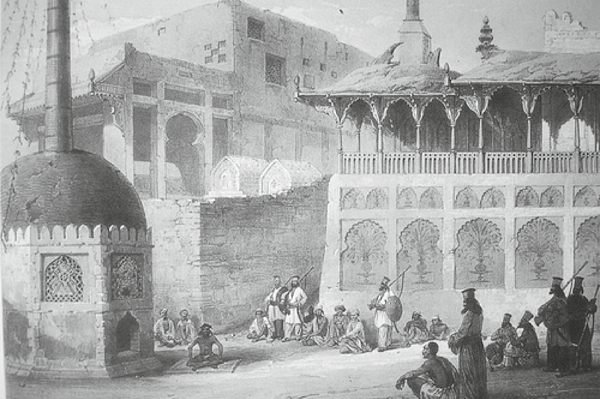
History has many instances on record of the siege of this fort. Raja Chach, after usurping the throne of Sindh went on a tour of his dominions. He had to face acute opposition at the hands of Mattah, the Governor of Sehwan, but eventually Chach succeeded and the fort passed into his hands. Once again in the early years of the 8th century A.D. Md. Kasim invaded the country and laid siege to the fort of Sehwan. Bachera, the nephew of the ruling Monarch, Dahar, commanded the fort. The population was Budhistic and hence they were reluctant to fight and the fort of Sehwan was ceded to Islam without opposition.
During the Moghul rule Sehwan was the scene of offence several times. Humayun having lost India on the banks of the Ganges and ran for his life followed by Sher Shah. He came to Sindh in 1541 to consolidate his position. After leaving Charbagh near Bakhur, he came down to Pat and had his love affair. Thence “the fugitive emperor made a determined attempt to get the possession of Sehwan, but it was strongly fortified and defied him.” It was taken by Akbar after seven months investment and was dismantled. Once again it became the scene of action when Aurangzeb and Dara contested the throne of Delhi. Dara the beloved son of his father, having been defeated by his own brother Aurangzeb, near the capital had come down to Lahore to make a fresh and determined bid for the throne. But soon he had to flee from Lahore. Hot pursuit of his brother's blood-hounds did not afford Dara to think for a moment wither he was bound, till he was closed up by his enemies near Sehwan. Here his position became definitely disappointing and the final doom loomed large in the camp of his followers. In the small bed of the Indus near Sehwan he was surrounded by his blood thirsty enemies. On the left bank of Indus he was faced with heavy guns mounted on the bassions of the Sehwan fort, under the personal supervision of Md. Saleh Targhan, the Killadar; on the other side Shikan Khan was coming at the head of powerful and large army. It was not time for effecting a retreat since on the other side Shaikh Mir was coming in hot haste to blockade the fugitive prince. It seemed the flame of life was getting extinguished. It was pretty exhausted. At this time nature came to rescue. A storm broke out. It suddenly became dark and in that hour of trial Dara was saved. His fleet was carried away by the wind to a place of safety. Thus Dara was detained to witness further humiliation and pain before he was finally released from this mundane world. And thus Sehwan was saved (spared) from the sin of the murder of a pious Sufi like Dara.
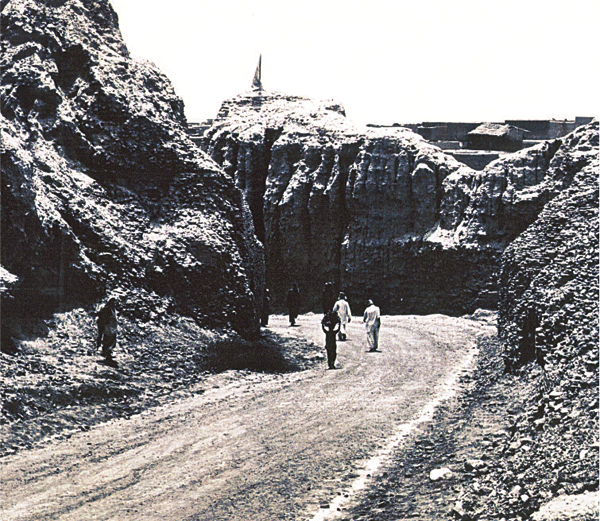
As late as the 18th century Nadir Shah, after the ransack of Delhi, while on his way back to his native land, dropped in Sindh and during that time, Sehwan was ransacked by the invader's army and the well known Seth Naoomal Hotchand Bhojwani the first Indian C.S.I complains in his memoirs that their Kothi, then situated at Sehwan was completely destroyed and all their saved sovereigns, secretly concealed in the beams supporting the walls of their house were made good by the army.
Yak Thambhi :
A structure standing on a single pillar. It is really a cave in a rock, standing on a single pillar of that rocky stone. It is believed that Lal Shahbaz Kalandar, had first occupied this, as his abode, before he entered and earned himself a shrine that none has so far secured in all Sindh. The suggestion of Dr. Cousens that this cave is a relic of bygone stone age when no families had existed has no formidable argument to support it. The cave is pretty dark and warm. Above this spot is an octagonal stand of well baked bricks. On the four alternate sides stand four poles which seem to be like the holders of a Shamiana. This place has commanding view. It is said to have been used by the rulers for reviewing their troops.
Shrine of Lal Shahbaz Kalandar :
Sehwan had certainly declined from its earlier glory by the 13th century. But it rose to distinction, once again, by becoming the resting place of “one of the greatest of all saints who have bequeathed their bones to Sindh” namely, Lal Shahbaz Kalander. A Mausoleum stands in the heart of the town wherein lie the remains of the great one. He is so much venerated for his piety that the compiler of the Gazetteer of the province of Sindh is at a loss to find out as to who originally built the tomb of this holy man. He writes, “It would be difficult to say who built his tomb, for almost every pious ruler of Sindh or Sehwan has contributed something to it.” Burton writes about the tomb thus “This quadrangle with a dome and lantern is hounoured to Usman-i-Merwandi, popularly called Kalader Lal Shahbaz or the Red Falcon of Merwandi, his natal province. The mausoleum is one of the seven wonders of the Sindhian world for magnitude and magnificence.
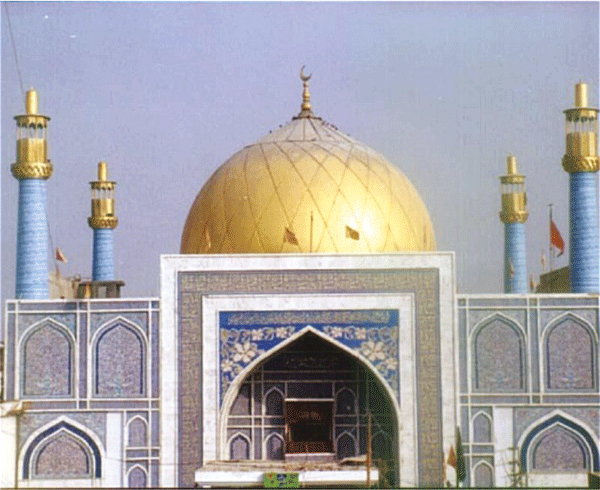
The shrine is sacred to both Hindu and the Muslim. To the Muslims because he was “Lal Saeen” and to the Hindu because he believes him to be the reincarnation of Raja Bharat Hari and due to the tradition that Raja Bharat Hari's Samadhi was at the same spot.

A fair is annually held on the 18th, 19th and 20th of the month of Shabban, in honour of the saint. On each of the three days, offerings from the three corners of the town are carried on the head of the eldest of the family living in the quarter, including a costly brocade. A very big procession accompanies the offerings. The procession is usually headed by well known Sufi singers. They arrange themselves into groups called Taifas and go on singing in a frenzy till they arrive at the tomb. The presents are ceremoniously offered to the Saint. On the first day the Sayads take the honours. On the second and the best day, the great honour is conferred by tradition on the family of the Nawanis, who are Hindus. On this day the fair is in full swing, and the town presents a gala appearance. The last day's honour is conferred on the Kanuga Hindus living in the third end of the town.

At the extreme end of Shroff Bazar on the fort side stands the house of the Saint. Outside the house there is a lamppost of wood. The pole is thickly covered with datefibre ropes such as are used in Charpoys. It is a local tradition that those who suffer from lingering fever can be cured of their ailment, if they tie to the post a piece of rope from the Charpoy on which they sleep.
Lakky Tirath :
About eleven miles to the south of Sehwan is a small village of “Lakky” and about two miles from this village there are hot water springs which flow from the mountains. Since the flow was continuous it was also called “Dhara Tirath.” There were two Dharamshalas near the station and the springs, where the travelers and various patients stayed. The steaming hot water flowed from the mountains and at the foot of the mountains there flowed a cool water fountain. There were three springs of hot water : one steaming hot, another tolerably hot and the third lukewarm. There were special bathing arrangements for the ladies. There was so much sulpher in the water that the people suffering from skin eruptions were cured by just taking the bath once only.
SOCIAL STRUCTURE :
Though the people from Sehwan like others from all Sindh observe Hindu tenets in the performance of their religious rites they (all Sindhis) aren't cast ridden as their co-religionists elsewhere in India. The Brahmin class among the Sindhis was very limited, (which includes Sehwanis as well), and both the Saraswat and Pushkarna Brahmins had restricted their activities to the performance of religious rites, offering instructions to those who sought it, and practicing Astrology, thus exercising no particular influence on society as such. They were merely a professional class. Sindh did not boast of any Kshiataries and there was no trace of any Sudra class among the Sindhis as such Islam had easily absorbed them in its initial campaigns in the valley of the Indus in the 8th century A.D. Hence bulk of the Sindhis caste-wise are Vaish. Sehwanis like all Sindhis had taken to certain well marked activities and their social set up was entirely based on their vocations.
Sehwanis like rest of the Sindhi community were grouped conveniently under two broad heads : Amils and Bhaibunds. Both the groups had their separate panchayats. Both the groups, Amils and Bhaibunds later on merged with each other and formed once common panchayat, and then there were just Sehwanis only no Amil or Bhaibund (as explained by late Principal Motilal Butani in Sindhi weekly Hindwasi – 26 August 1990). The Panchayat looked after the social welfare of the members of the community, resolved social disputes and curbed undesirable tendencies. The Panchayat exercised considerable influence on its members. It could outcast a man if he was persistent in opposing its mandates. No one could afford to be thus socially boycotted. But after the partition the Panchayat gradually lost its former prestige and power and now serves only to keep the people socially together. This holds true for other Sindhi Panchayats also.
RELIGIOUS TENETS, BELIEFS AND PRACTICES :
Sindhis (including Sehwanis) generally speaking follow the Hindu Scriptural rites performed by the Brahmins. But due to Muslim bigotry prevalent in Sindh since the 8th century A.D. a strict and detailed adherence to the Hindu religion and practices was impossible. Particularly during the two centuries preceding the British annexation of Sindh in 1843, the Hindus were debarred ever from observing their religious festivals and festivities in public. Naturally therefore the Hindu practices greatly watered down in number and strict adherence; and yet their observance was enough to distinguish the follower to be a Hindu. The Sindhi could boast of worshipping at the shrines of Lords Vishnu and Shiva as also of Kali particularly, when he acquired freedom of worship under the British. The presence of ancient Shiva temple in Sehwan as shown in the map by late
Principal Motilal Butani and the well established fact that the original name of Sehwan was Siwistan it can be safely said that Sehwanis worshipped Lord Shiva as their main deity, although worship of Shakti in the shape of Devi, Kali, Sitla Bhavani etc. was also in practice.
Apart from Hinduism the Sikh faith also exercised considerable influence among the Sindhi Hindus including the
Sehwanis as well. But the actual following of the Sikh faith was very limited, though a general belief in the Sikh Gurus was considerable. For example on every new moon day invariably the Hindu families subscribed to the Sikh “Prasad,” but not all Hindus followed any other Sikh rites of birth, marriage or demise. A general faith in Sikhism was in addition to the main faith in Hinduism.
PEOPLE AND THEIR PROFESSION
Due to an extensive and fertile hinterland the town of Sehwan became the chief market place for all central Sindh. Industrial products and agricultural produce were brought to Sehwan from Boobak, Talti, Sann, Arazi, and other areas far and near, and gave rise not only to a brisk local trade, but also to extensive commerce by the Indus, the great waterway of Sindh. Beehive activity made the town more populous and the townsfolk rich and prosperous. This is attested by the large mendicant population sustained by Sehwan, as adduced earlier. As a result merchants and traders abounded in the town.
Being the seat of government Sehwan also provided substantial opportunity for government employ. At the top of the official class stood the Munshi, the confidant advisers to the Ruling Chief. Like Munshi Gidumal of Hyderabad, Sehwan boasts of a family of Munshis – the Nawanis. Late Shri Hiranand Bhojraj's ancestors were confidant advisers to the rulers during the Talpur period, prior to the British conquest of Sindh in 1843. Next in importance were the Kanugas – speakers of the law of rights – truly the keepers of record of Rights. They determined the quantum of land revenue that was payable to government by the land owners. Naturally, the Kanugas could not be numerically strong, but by their designation and nature of work they wielded considerable power and authority. The Kanugas never permitted their womenfolk to venture out of their houses during daytime; they could come out only after dark, presumably to avoid evil and cupid eyes! Further, the Kanugas married from other families of Sehwan, but without exception gave their daughters in marriage to rich merchant families of Nasarpur and Thatta, so that they would enjoy the wealth of their great in-laws and wield domineering influence over them since they had acquired it in their parental homes! More numerous than the Kanugas were the Amils, the actual collectors of revenue. There were varied grades of Amils, the highest of which were the Kardar.
Some Butani families of Sehwan, who accompanied the Kalhora Chief when he established his new capital at Hyderabad, became his Kardars. Similarly other families enjoyed employment in other caders. There were others who held other gainful employment under the government, and they were styled generically as Kamoras. These appellations have later changed in value and importance, so that Munshi is today virtually a term of reproach, the Amil has come to mean an educated person, and the term Diwan is being frequently used as a designation signifying respect mainly on account of age or position in state employment, having really nothing to do with finance, to which the term originally refers. Nobody in all Sindh ever was a Diwan in the literal and the official sense of the term.
Among the merchant and trading class the most well-known and the most numerous were the Samtanis. They lived in and around Sehwan in what was denominated as the Samtani Pargana (like Chandka Pargana around the town of Larakana) and were so enterprising and venturesome that on the setting-up of the new capital at
Hyderabad by the Kalhoras, they accompanied the Butanis, and settled down in the new city. The Samtanis burnt a brilliant trail after establishing themselves at Hyderabad, by spreading out to south Asia, marketing Sindh goods and Indian products. They started in good company and prospered exceedingly well. Sehwani young men married Samtani daughters, being lured by the Dower they received, in addition to every and any other consideration, although the Dowry system as such had not become the vogue yet. The Samtanis ingrained themselves so well at Hyderabad that some of the younger generation have clean forgotten that they hail originally from Sehwan.
Next to the Samtanis were Bhojwanis. Seth Bhojoomal started his career in Sehwan, as is recorded by Seth Naoomal Hotchand Bhojwani, an illustrious scion of the family, in his Autobiography. In the loot of Sehwan by the soldiers of Nadir Shah, the Bhojwani 'Kothi' was razed to the ground, to secure gold coins, hoarded in the wall and pillars of the structures!! The Bhojwanis spread-out their wings fairly widely, to Khrak Bunder,
Karachi and Hyderabad, etc. But for social considerations they claim to hail from Hyderabad, though they really belong to suburban Sehwan.
There are mainly two broad classes of merchants and traders – the small-shop tradesmen called the Banias, and the bulk traders and wholesale merchants styled as the Bhaibunds, who set the ball rolling in foreign trade like Samtanis.
And there were Thakurs – Bhundhai Thakurs from their ancestor, 'the Chief custodian of the Daryapanthi faith of Uderolal or Amarlal.' The Indus being the source of life of Sindh, the merchant, the trader and the land-holder alike worshipped the River God with unparalleled devotion, for survival and for prosperity, and when wealth came their way, they were not averse to sharing it with their God, through his custodians, the Thakurs. No wonder, therefore, that the water-worshippers from Sindh still continue to pay their homage sumptuously, and at least some of the Thakurs of Sehwan continue to be well off still although of late quite a number of them especially the younger generation who took to education, have taken to private and government employment.
After the British conquest of Sindh in 1843, whole pattern of life underwent a change. More and more people took to education and varied avocations hither to unimagined, and the
Sehwanis did not lag behind. They took to education avidly and won laurels for themselves in varied fields of activity and employment.
Sehwan has produced many an illustrious son, chief among them being Abul Fazul and mula Faazi – two jewels of Mughal emperor Akbar's court.
http://www.sindhishaan.com/article/history/hist_08_02a.html

